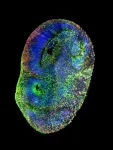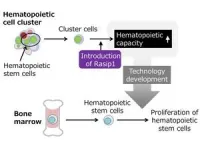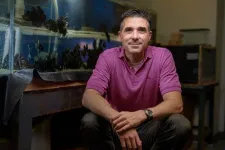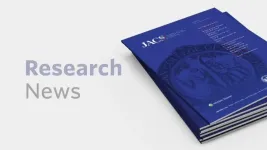(Press-News.org) Does the human brain have an Achilles heel that ultimately leads to Autism? With a revolutionizing novel system that combines brain organoid technology and intricate genetics, researchers can now comprehensively test the effect of multiple mutations in parallel and at a single-cell level within human brain organoids. This technology, developed by researchers from the Knoblich group at the Institute of Molecular Biotechnology (IMBA) of the Austrian Academy of Sciences and the Treutlein group at ETH Zurich, permits the identification of vulnerable cell types and gene regulatory networks that underlie autism spectrum disorders. This innovative method offers unparalleled insight into one of the most complex disorders that challenge the human brain with implications that bring autism clinical research much-needed hope. The results were published on September 13 in Nature.
Compared to other animal species, the human brain has a mind of its own. To develop, the human brain relies on processes unique to humans, allowing us to build an intricately layered and connected cortex. These unique processes also make neurodevelopmental disorders more likely in humans. As an example, many genes conferring a high risk of developing autism spectrum disorder (ASD) are crucial for cortex development. Although clinical studies have shown causality between multiple genetic mutations and autism, researchers still do not understand how these mutations lead to brain developmental defects – and because of the uniqueness of human brain development, animal models are of limited use. “Only a human model of the brain can recapitulate the complexity and particularities of the human brain,” says IMBA Scientific Director Jürgen Knoblich, one of the study’s corresponding authors.
To help crack this black box open, researchers from Jürgen Knoblich’s and Barbara Treutlein’s research groups at IMBA and ETH Zurich developed a technique to screen a complete set of key transcriptional regulator genes linked to autism. This development is especially impactful since the genes of interest can be examined simultaneously within a single mosaic organoid, marking the beginning of an era of intricate, efficient, and expedient genetic screening in human tissue. In the newly developed system, called “CHOOSE” (CRISPR-human organoids-scRNA-seq), each cell in the organoid carries at most one mutation in a specific ASD gene. The researchers could trace each mutation’s effect at a single-cell level and map each cell’s developmental trajectory. “With this high-throughput methodology, we can systematically inactivate a list of disease-causing genes. As the organoids carrying these mutations grow, we analyze the effect of each mutation on the development of each cell type,” says the study’s first and co-corresponding author Chong Li, a postdoctoral fellow in the Knoblich group.
A high-throughput systematic approach
With the CHOOSE system, the IMBA and ETH Zurich teams advance research on disease-causing genes by a whole leap, providing researchers with access to a versatile and high-throughput method that can be applied to any disease and in any human model system. Importantly, CHOOSE considerably speeds up the analysis in comparison to traditional genetic loss-of-function approaches. “We can see the consequence of every mutation in one experiment, thus shortening the analysis time drastically when compared to traditional methods, using an approach that for decades was only possible in organisms like the fruit fly”, explains Knoblich. “Additionally, we can still benefit from a hundred years of scientific literature about disease-causing genes.”
Mutating several genes in parallel and tracking their effects generates an enormous amount of data. To analyze this complex dataset, co-corresponding author Barbara Treutlein and her team at ETH Zurich used quantitative bioinformatics and machine learning approaches. “Using this high-throughput single-cell expression data, we can quantify whether a given cell type is more or less abundant due to a given mutation, and we can also identify sets of genes that are commonly or distinctly affected by each mutation. By comparing across all the gene mutations, we can reconstruct the phenotypic landscape of these disease-linked genetic perturbations,” explains Treutlein.
Learning about autism during development
Using the CHOOSE system, the researchers show that mutations of 36 genes, known to put carriers at high risk of autism, lead to specific cell type changes in the developing human brain. They identified critical transcriptional changes regulated through common networks, called “gene regulatory networks” or GRNs. A GRN is a set of molecular regulators that interact with each other to control a specific cell function, explains Li. “We demonstrated that some cell types are more susceptible than others during brain development and identified the networks that are most vulnerable to autism mutations,” he adds.
“With this approach, we learned that autism-causing genes share some common molecular mechanisms,” says Knoblich. Yet, these common mechanisms can lead to markedly distinct effects in different cell types. “Some cell types are more vulnerable to mutations that lead to autism, especially some neural progenitors- the founder cells that generate neurons. This is true to the point that the pathology of autism could already emerge early during brain development. This indicates that some cell types will necessitate more attention in the future when studying autism genes,” says Li.
To confirm whether these findings are relevant to human disorders, the researchers teamed up with clinicians from the Medical University of Vienna and generated brain organoids from two patient stem cell samples. Both patients had mutations in the same gene that caused autism. “The organoids generated from both patients showed marked developmental defects linked to a specific cell type. We could validate these in vitro observations by comparing the organoid structures to the prenatal MRIs of one of the patients’ brains,” says Knoblich, showing that the organoid data closely matched clinical observations.
Beyond the brain and autism…
In addition to gaining unparalleled insights into the pathology of autism, the team underlines the versatility and transferability of the CHOOSE system. “We anticipate that our technique will be widely applied beyond brain organoids to study various disease-associated genes,” says Knoblich. With this new technique, scientists and clinicians gain a robust and precisely controlled high-throughput screening tool that considerably shortens analysis time and provides invaluable insights into disease mechanisms.
IMBA Scientific Director Jürgen Knoblich is also a Professor in Synthetic Biology at the Medical University of Vienna.
Original publication:
Li, C., Fleck, J. S., et al., Single-cell brain organoid screening identifies developmental defects in autism. Nature, 2023. DOI: 10.1038/s41586-023-06473-y
https://doi.org/10.1038/s41586-023-06473-y
About IMBA:
The Institute of Molecular Biotechnology (IMBA) of the Austrian Academy of Sciences (ÖAW) is one of Europe’s leading biomedical research institutes. IMBA is located at the Vienna BioCenter, Austria's vibrant cluster of universities, research institutes, and biotech companies. IMBA research topics include chromosome biology, RNA biology, selfish elements and silencing mechanisms, functional genomics, cell and developmental biology, stem cell biology, molecular medicine, neuroscience, organoid research, and disease models.
END
CHOOSEn fate: one brain organoid’s tale on Autism
2023-09-13
ELSE PRESS RELEASES FROM THIS DATE:
Pixel-by-pixel analysis yields insights into lithium-ion batteries
2023-09-13
CAMBRIDGE, MA -- By mining data from X-ray images, researchers at MIT, Stanford University, SLAC National Accelerator, and the Toyota Research Institute have made significant new discoveries about the reactivity of lithium iron phosphate, a material used in batteries for electric cars and in other rechargeable batteries.
The new technique has revealed several phenomena that were previously impossible to see, including variations in the rate of lithium intercalation reactions in different regions of a lithium iron phosphate nanoparticle.
The paper’s most significant practical finding — that ...
Long-term quality of life after out-of-hospital cardiac arrest
2023-09-13
About The Study: In this survey study of 2,552 survivors of cardiac arrest in Denmark, health-related quality of life up to 20 years after the event was consistently high across follow-up periods and comparable to the general Danish population. These findings support resource allocation and efforts targeted to increasing survival after out-of-hospital cardiac arrest.
Authors: Harman Yonis, M.D., of Nordsjallands Hospital in Hillerod, Denmark, is the corresponding author.
To access the embargoed study: Visit our For The Media website at this link https://media.jamanetwork.com/
(doi:10.1001/jamacardio.2023.2934)
Editor’s ...
Economic evaluation of extended-release buprenorphine for persons with opioid use disorder
2023-09-13
About The Study: In this economic evaluation of extended-release buprenorphine compared with transmucosal buprenorphine for the treatment of opioid use disorder, extended-release buprenorphine was not associated with efficient allocation of limited resources when transmucosal buprenorphine was available. Future initiatives should aim to improve retention rates or decrease costs associated with extended-release buprenorphine.
Authors: Juliet M. Flam-Ross, B.A., of the London School of Hygiene and Tropical Medicine in London, and Sabrina A. Assoumou, M.D., M.P.H., of the Boston ...
Solving stickiness sustainably
2023-09-13
WEST LAFAYETTE, Ind. – Glue holds the world together. Without adhesives, much of modern human civilization — including our cellphones, cars, furniture, walls and the packages arriving on our doorstep — would simply fall apart.
The trouble with all those adhesives is that they are not sustainable. A team of chemists at Purdue University led by Jonathan Wilker, professor of chemistry in the College of Science and of materials engineering, aims to change that with a new, completely sustainable adhesive system. The team’s findings were released in a paper in Nature.
Additional Information
Shellfish ...
Mysterious family of microbial proteins hijack crops’ cellular plumbing
2023-09-13
DURHAM, N.C. -- Many of the bacteria that ravage crops and threaten our food supply use a common strategy to cause disease: they inject a cocktail of harmful proteins directly into the plant’s cells.
For 25 years, biologist Sheng-Yang He and his senior research associate Kinya Nomura have been puzzling over this set of molecules that plant pathogens use to cause diseases in hundreds of crops worldwide ranging from rice to apple trees.
Now, thanks to a team effort between three collaborating research groups, they may finally have an answer to how these molecules make plants sick -- and a way to disarm them.
The findings appear Sept. 13 in the journal Nature.
Researchers ...
World-first AI foundation model for eye care to supercharge global efforts to prevent blindness
2023-09-13
Researchers at Moorfields Eye Hospital and UCL Institute of Ophthalmology have developed an artificial intelligence (AI) system that has the potential to not only identify sight-threatening eye diseases but also predict general health, including heart attacks, stroke, and Parkinson’s disease.
RETFound, one of the first AI foundation models in healthcare, and the first in ophthalmology, was developed using millions of eye scans from the NHS. The research team are making the system open-source: freely available to use by any institution worldwide, to act as a cornerstone for global efforts to detect and treat blindness using AI. ...
Researchers identify lesser-known factors associated with firearm violence
2023-09-13
Key takeaways
Social determinants of at-risk neighborhoods: Higher proportions of poverty and low per-capita income were most associated with higher rates of shooting incidents.
High levels of social stressors: The study found that fatal and non-fatal firearm assaults were clustered in neighborhoods with high levels of social stressors measured with the 2018 version of the Centers for Disease Control and Prevention’s (CDC) Social Vulnerability Index (SVI).
A potential tool for directing anti-violence initiatives: The CDC’s SVI can help policymakers target neighborhoods at ...
The origins of blood: Researchers identify a gene critical to blood production
2023-09-13
Researchers from Tokyo Medical and Dental University (TMDU) have discovered that a gene called Rasip1 is intimately involved in the creation of blood cells
Tokyo, Japan – Blood has long been a symbol of life and health, so it may be surprising that some aspects of blood production, i.e., hematopoiesis, remain incompletely understood. One such mystery is the role of a protein called SOX17. Blood cells are generated by hematopoietic stem cells (HSCs), and SOX17 seems to be important to the development of HSCs because SOX17 is expressed where HSCs first develop. What exactly SOX17 does, however, has remained unclear.
Now, a research team at Tokyo Medical and Dental University (TMDU) ...
Ohio’s droughts are worse than often recognized, study finds
2023-09-13
COLUMBUS, Ohio – A new type of analysis suggests that droughts in Ohio were more severe from 2000 to 2019 than standard measurements have suggested.
Researchers at The Ohio State University developed impacts-based thresholds for drought in Ohio, looking specifically at how corn yield and streamflow were affected by various drought indicators, such as notable changes in soil moisture, crops, and even livestock losses in the state.
The results suggest this impacts-based approach could give Ohio farmers earlier and more accurate notice when drought conditions are approaching, said Steven Quiring, co-author of the study and a professor ...
Building the first-ever digital twin of the bladder
2023-09-13
Men ages 50 to 60 have an 80 percent chance of having some degree of bladder outlet obstruction (BOO) due to an enlarged prostate – which causes multiple symptoms that can impact their lives physically and psychologically.
The bladder, an incredibly complex organ, has its own electrical system and can change its constituents and geometry through a growth and remodeling process. However, in bladders with BOO, the urethral resistance increases and forces the muscle cells within the bladder to generate larger pressures to void. Over time, the bladder adapts with a growth and remodeling response that causes changes in bladder size, tissue composition, ...





